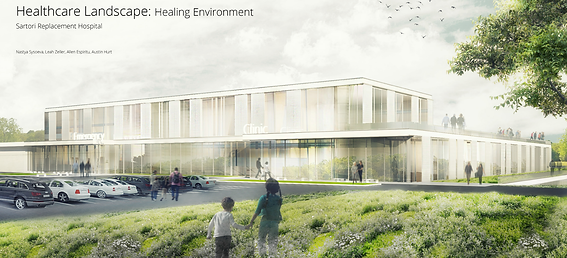Bachelor of Architecture
Austin Hurt
Portfolio
Inpatient Redesign
Disrupt/Displace
Neal Smith National Wildlife Refuge Visitor's Center

Replacement Hospital

Clay 3D Printing


3D Printed Arm Cast



This project is a full hospital design for Iowa City, Iowa. The hospital has a bottom floor sunken under the ground housing most of the functions that do not require windows to the outside (such as surgical rooms and a few therapy functions). The central floor is comprised of the emergency functions, and the top floor houses the mental health ward. The center of the building is cut out to create a garden in the center. This gives almost all functions of the hospital that can benefit from natural light, access to an open garden space. This helps the patients because it gives them views, natural lighting, and a wayfinding point of reference. Each of the four corners of the garden houses one of the vertical circulation cores. Each core is separated from each other allowing staff, patients, and public to never cross each other to reduce problems with cross contamination.
An exploration with new digital fabrication media, I developed a series of ceramic bricks with a clay 3D printer. The bricks use a series of three cones that allow for a tripod connection to the ground and easy stacking in a number of different ways. Clay has different material properties than many of the other materials I have 3D printed with and took a lot of trial and error to get it right. The project taught me a lot about working with digital
fabrication machinery and materials I was not
previously familiar with.
Seattle Aquatic Aviation and Maritime Museum
Gasworks Park in Seattle used to be a coal distillation plant that was eventually shut down. The plant heavily contaminated the soil, and when the site was converted into a public park, the site was never cleaned up properly. The park still to this day occasionally oozes tar and the silt in the water can release toxins into the water if disturbed. The proposal for the Seattle Aquatic Aviation and Maritime Museum (SAAMM) uses itself to help remediate the still-contaminated site. The land that is cut to build the basement of the building is taken and introduced to a chelator. It is then used to create an extension to the park known as the Remediation Garden. The garden uses a process known as phytoremediation, using a series of plants that can absorb the toxins from the soil to help remediate the ground. The
chelator added to the soil helps the plants absorb the toxins. A pump-and-treat system is implemented, drawing water from the surrounding lake and filtering it. The filtered water is then used in a chilled beam system to heat and cool the building before being put back into the lake as clean water.
Most 3D printed casts today cost upwards of three hundred dollars and require a print time of five to twelve hours. This arm cast uses a series of metal rods as a splint with a series of 3D printed pieces. Taking this approach reduces the print time significantly as well as reducing the cost of materials and fabrication. The cast is made of six parts with the middle two pieces being adjustable to stabilize to the specific break in the arm.
Working with representatives from the Waterloo office of INVISION Architects, we redesigned the existing inpatient wing of Regional Medical Center in Manchester, Iowa. The room design was angled for the sake of patient and family views outside of the building as well as a nurse’s view of the patient in each room for safety. This also increases the window surface in each patient’s room and increases the amount of light able to enter the space. The angled plan allows for a view down each hallway to the nurse’s station for the sake of way finding and to help in case of an
emergency.
Disrupt/Displace was Iowa State University’s
submission to the Venice Biennale conference for 2016 in Venice, Italy. The theme for the Venice Biennale was “Reporting from the Front” with the idea of bringing controversial front lines in today’s society from various regions of the globe to light with the hopes of making an architectural dialogue between different cultural groups of people to help find new solutions. Disrupt/Displace brings the
controversial topic of the Bakken Pipeline
construction to the conference. The Bakken
Pipeline is a crude oil pipeline that cuts a
diagonal path through much of the Midwest. This brings crude oil to the United States for easier access but poses the problem on Midwestern farmers through the abuse of imminent domain forcing farmland to be taken from farmers for the construction of the pipeline.
Finalist for the 2016 Hansen Prize. The center uses required ADA accessible ramps as a way to use the campus as a learning tool for visitors by weaving them through the four main wetland types that used to exist in Iowa before it was cultivated for farmland. The center is used for educating guests on the natural
environment that used to make up the Midwest as well as connect to existing hiking trails.






